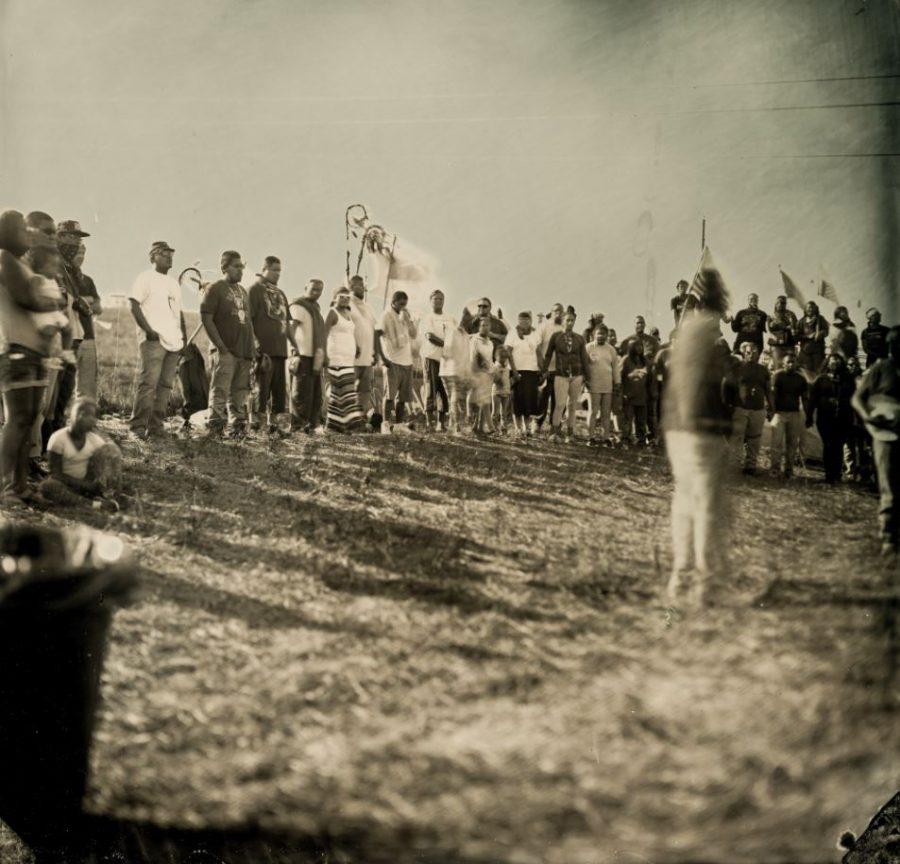Native Americans Face Off with Police at Standing Rock
A tribe elder addresses protesters blocking the pipeline
It’s Native Americans vs. police in Cannon Ball, North Dakota.
In Cannon Ball, North Dakota, scores of Native Americans and their fellow citizens are standing in protest of a pipeline set to go right through Native American ancestral ground. There, Native Americans once fished, hunted, and were even buried. It is not part of the reservation, which was created by The Agreement of 1877.
The Agreement of 1877 annexed land from Native Americans. Technically, the U.S. government needed three fourths approval from male Native Americans to take the land, but neither tribes occupying it were willing to negotiate. The U.S. government, to the cries of both the Dakota and Lakota tribes, simply annexed the land without Native American approval, instead enacting the 1876 act, which gave took the land. Due to the power of the U.S., the Native Americans at Standing Rock had no choice but to try to adapt to the restrictions imposed upon them by the U.S.
But in April of this year, they had had enough. The Energy Transfer Brothers, the company building the pipeline, had government approval and began construction. It began with only the Standing Rock Sioux Tribe, but has since grown. Native Americans from all over the country have come out to stand with the Standing Rock tribe, and so have ordinary citizens. It is estimated that the protesters now number several hundred people.
The sacred Native American land isn’t the only thing the pipeline will go through, however. The plans have it moving directly underneath the Missouri River, the source of drinking water for thousands. So far this year, the U.S. has had 220 oil pipeline leaks.
Proponents of the pipeline say it will create between eight to twelve thousand construction jobs and improve local economy in the areas it runs. It will bring 470 thousand barrels of oil from the fields in North Dakota to Illinois, where it would be connected to other pipelines.
Among all this controversy, the pipeline is still being built. The Obama administration urged the Energy Transfer Brothers to stop, but did not force them to and as such they have continued construction. President elect Donald Trump has said nothing about the situation, and even has investments in the pipeline.
The protests have been intense. Mace has been employed in large amounts, and intimidating dogs have been brought to the scene. Photos and videos show protesters being treated for injuries, and the tribal spokesperson claims protesters have been bitten.
The original route of the pipeline had it crossing the Missouri River near Bismarck, North Dakota, the state’s capital. The 129,517 citizens of Bismarck rejected the pipeline. The pipeline’s river crossing was then moved near the Standing Rock Native American Reservation where it remains, though rejected again by the citizens of that area.
Mr. Gunn, a history teacher at Williston, believes the issue is made up of three questions. The first is the question of the impact building the pipeline upon traditional Native American homelands would have on the Sioux.
“I would make sure, in this case, that the sovereign authority of the Sioux is respected, and that we go to great lengths, even when it is not legally necessary to address their concerns to the fullest extent possible,” Gunn said.
Gunn also thinks that the involuntary nature of the Sioux people becoming part of the U.S. should be taken into account when considering this issue.
Also brought up was the broader question of the environmental impact. Gunn urges environmentalists to be ready to subsidize those whose energy bill would increase. He believes trying to “leapfrog” to clean sources of energy would impose extraordinary costs on the end consumer. “There is no cost free solution,” he said.
The broadest question brought up was of what energy direction the country is taken. “We are going to continue to pipe oil and gas for the foreseeable future,” Gunn said. He also strongly urges economic help for those who cannot pay for the more expensive clean energy and would suffer if forced to transition to it.
Though Gunn is against the pipeline, he also recommends environmentalists to recognize the economic expense imposed upon the poor in America when these types of pipelines are halted.
UPDATE: The Dakota Access Pipeline has been temporarily put on hold and must now go through environmental review.
















